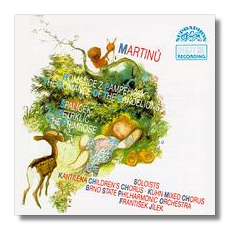
The Internet's Premier Classical Music Source
Related Links
- Martinů Reviews
- Latest Reviews
- More Reviews
-
By Composer
-
Collections
DVD & Blu-ray
Books
Concert Reviews
Articles/Interviews
Software
Audio
Search Amazon
Recommended Links
Site News
 CD Review
CD Review
Bohuslav Martinů

- Spalícek
- Dandelion Romance *
- Primrose **
Kratochvílová, soprano
Miroslav Kopp, tenor
Richard Novák, bass
Messiereur, violin
* Cejková, soprano
** Stanislav Bogunia, piano
Brno State Philharmonic Orchestra/František Jílek
** Kühn Female Chorus/František Jílek
Supraphon 110752-2 61:25 + 58:12
Summary for the Busy Executive: Joyful play.
The CD presents two little cantatas and a full ballet. A love of Czech folk tales and folk poetry unites them. After 1938, Martinů never saw his home again. In fact, it turns out that he spent more of his life outside Czechoslovakia than in it. He left for Paris in 1922 as the recipient of a six-month government stipend and stayed until the Nazis invaded France. Paris represented an alternative to what Martinů felt as Prague parochialism. Yet Paris also failed to satisfy him. After indulging in rather fashionable works himself, he found much of the artistic cosmopolitanism empty, although he admired Stravinsky, and throughout his life he suffered from fits of homesickness. Martinů usually signaled this mood in works that used Czech folk material as their foundation.
Folk music for Martinů was never a simple matter of quotation. Like his compatriots Dvořák and Janáček and like Vaughan Williams as well, he assimilated its essence, and it had the same effect on him as on the others of opening up his musical language. This took a number of years, and the road to his artistic self was not always straight and ever-forward. Nevertheless, we see the general progress in the three works recorded here. The "folk" works of Martinů speed up his maturity, often anticipating the idiom of his last period by decades.
Spalícek from 1932-33 is the earliest, most elaborate, and least-assured work here. One could very easily describe it as a ballet-revue, since it consists of several unrelated stories. To some extent, it reflects Martinů's dislike of realism; the lack of continuity between acts and even scenes counteracts any Tchaikovskian narrative impulse. The stories serve almost as pictures, as if one were to happen upon and browse a book of folk tales found in a second-hand bin. It requires solo voices (perhaps influenced by Stravinsky's Pulcinella) and a treble chorus. The work has previously been recorded as an instrumental suite (notably by Charles Mackerras on Conifer CDCF202, now deleted), but unfortunately that hides the true nature of the work. The voices emphasize the folk-song element, and we hear it as the spring of just about everything else in the ballet. Martinů revised the work in 1937 and in 1940, dropping the last act – The Spectre's Bride, now a separate piece available on Supraphon 111090-2 – and rearranging several parts. The uncertainty of the work stems not merely from its rearrangement, but from the hesitancies of the purely instrumental movements. If one compares Spalícek with the similarly folk-influenced Bouquet of Flowers, written only four years later, one sees in the latter work how much more thoroughly Martinů has integrated the folk element into his personal idiom, as well as a consistently higher level of invention. Nevertheless, one can see the fully mature Martinů peeking out here and there, especially in the second act, in such numbers as "The Magic Bag" and "At the Gate of Hell." In the companion piece, "At the Gate of Heaven," we get a bit of time-travel – quietly rapturous music that foreshadows the Symphony #6 of the Fifties. I don't really criticize the ballet. On its own terms, it's a beauty, especially the magnificent last act (which combines the stories of St. Dorothea and Cinderella), possibly because of the greater participation of the voices. But it isn't quite what Martinů became.
Primrose and Dandelion Romance come from Martinů's final period in the Fifties. Primrose is the simpler of the two works, a series of duets on Moravian folk texts for treble choir, violin, and piano. Treble voices brought out the best in Martinů's choral writing, for some reason, inspiring him to flights of vigorous counterpoint. This is a gem which, because of the language it's written in, will probably never be performed outside of the Czech Republic.
Dandelion Romance is the last of four cantatas on words by the poet Miroslav Bures. You can find the other three on Supraphon 110767-2. I have no idea why Supraphon decided to break them up. At any rate, the Romance is an unusual work, as it's a cappella for mixed voices. It opens with the most rapt C-major chord you've ever heard and tells of a young girl waiting for her lover, gone seven years. The text ends ambivalently. We don't know whether the lover is dead in the wars or married to someone else. The music ends in a bright shimmer, like the jeweled wing of an insect, as the choir celebrates the true heart of the girl.
Wonderful performances of wonderful music.
Copyright © 2001, Steve Schwartz


















